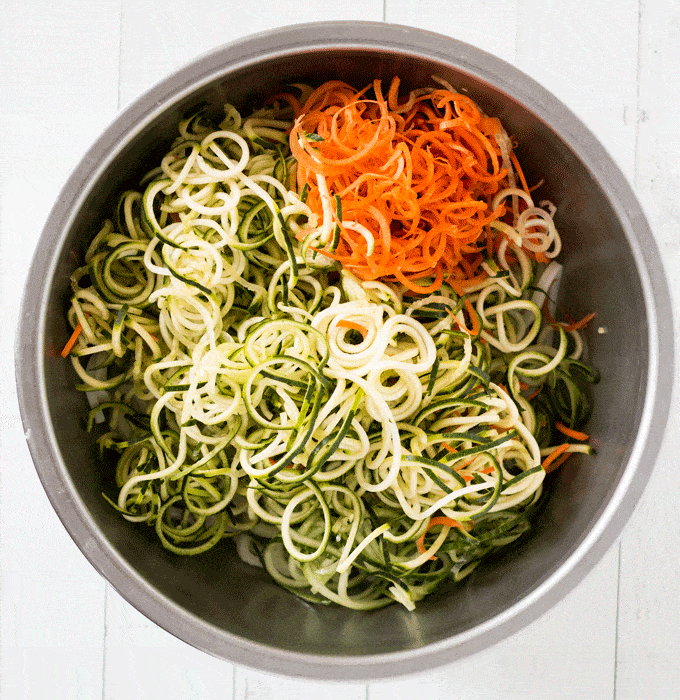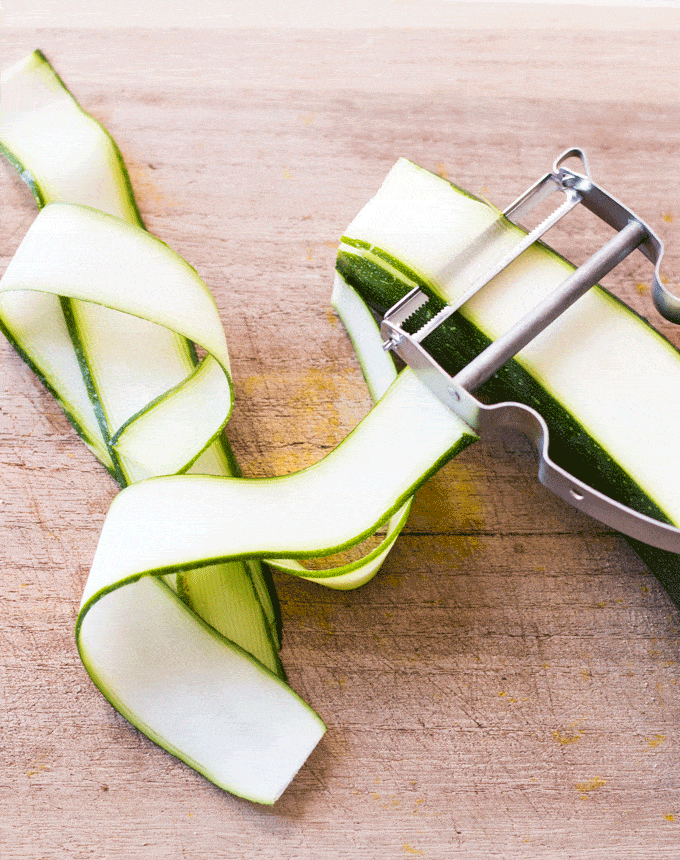Are you looking for a way to enjoy your favorite noodle dishes while getting more veggies in your diet? With various vegetables turned into noodles, the possibilities for tasty and healthy meals are endless! With this easy guide, learn how to make your own veggie noodles at home.

Veggie Noodles
Noodles are a staple in many cuisines, from Italian pasta to Asian noodles like Japanese ramen.
Veggie noodles are a great alternative if you are looking for a healthier and lower-carb option, or simply want to include more veggies in your diet.
Not only are they packed with nutrients and fiber, but they also add color, flavor, and texture to your dishes.
How To Use Veggie Noodles
How you cook your vegetable noodles will depend on what vegetable you have used to make them.
For hardier vegetables like sweet potatoes, you can quickly sauté them with seasoning, herbs, pesto, or a stir-fry sauce until they are more tender, but for noodles made from vegetables like zucchini, you will likely need to add your sauce, warm through, and away you go.
They also make a great addition to cold salads like this cold zucchini udon noodle bowl, where you simply add a dressing and toss to combine before serving.

How To Pick the Best Vegetables for Making Noodles?
If you are new to making veggie noodles, there are a few things to consider when choosing your veggies:
- Choose firm and relatively straight vegetables, as these will be easier to spiralize: opt for firmer varieties that will hold their shape when spiralized or sliced into noodles. Vegetables like zucchini, carrots, sweet potatoes, and cucumbers work well for this purpose.
- Consider taste and texture: think about what flavors you enjoy and what kind of texture you're looking for in your noodles. For example, zucchini noodles are mild in flavor and have a slightly crunchy texture, while sweet potato noodles are sweeter and have a softer texture once cooked.
- Look for colorful options: adding a few colors to the mix not only looks good but adds a ton of nutrition as well. Try incorporating different colored vegetables such as bell peppers, beets, or purple cabbage to create a vibrant and nutrient-rich meal.
- Check freshness: choose vegetables that are at their peak ripeness. Look for produce that is firm with no signs of wilting or browning.
Gadgets Used for Making Vegetable Noodles
There are several gadgets for making vegetable noodles. Some of the most popular include:
- Spiralizer: A spiralizer is a device that creates long, thin noodles from vegetables. It has different blades that can make different shapes and sizes of noodles. These come in all shapes and sizes, so consider how often you will be making the noodles and how many people you will be serving. I have a large spiralizer as I am feeding a family of 5, however my parents have a little handheld version seeing as it's just the two of them.
- Julienne Peeler: A julienne peeler is a handheld tool to create thin, uniform strips of vegetables. It works similarly to a regular vegetable peeler but has a serrated edge that cuts the vegetables into thin strips.
- Mandoline Slicer: A mandoline slicer is a kitchen tool that allows you to slice vegetables into thin, uniform strips or slices. It has an adjustable blade for different thicknesses, depending on the type of noodles you want to make.
- Vegetable Spiral Slicer: Can be used to create spiral-shaped noodles from vegetables. It works by inserting the vegetable into the device and turning it to make the noodles.
- Regular vegetable peeler: A regular peeler to make wider slices if no other gadgets are available. This will make the noodles more akin to the size and shape of flat rice noodles.
Each gadget has its own advantages and disadvantages, and the best one for you will depend on your preferences and needs.

Type of Vegetables Make Veggie Noodles
“Making spiralized noodles out of veggies is incredibly easy to do! Zucchini is the most common you’ll see and one of the easiest. They are a great low carb noodle substitute if you’re trying to reduce your carbohydrate intake or go gluten free.”
— Lara Clevenger, Lara Clevenger
From classic zucchini noodles to unconventional options like carrot and parsnip noodles, here are some of the vegetables you can use to get started:
Zucchini Noodles
Zucchini noodles, also known as zoodles, are the most popular veggie noodle. They are easy to make, low in calories, and have a mild flavor, making them an excellent substitute for traditional pasta. You only need a spiralizer or a vegetable peeler to make zucchini noodles. Once you have your zoodles, you can cook them in various ways, such as by sautéing, boiling, or baking.
This cold zucchini udon noodle bowl uses zucchini, carrot and cucumber noodles.
Carrot Noodles
Carrots are another great vegetable to turn into noodles. Carrot noodles, also known as cooldles, have a slightly sweet flavor that pairs well with many different sauces and seasonings. You can prepare them in various ways, such as by sautéing, boiling, or roasting. Like zucchini noodles, you can make carrot noodles with a spiralizer or a vegetable peeler.
Sweet Potato Noodles
If you’re looking for a heartier veggie noodle, sweet potato noodles, also known as swoodles, are a great option. They have a slightly sweet flavor. They work well in both sweet and savory dishes.
Beet Noodles
Beet noodles are a colorful and flavorful option for veggie noodles. They have a slightly earthy flavor and a beautiful, vibrant color. They work well in salads or as a base for bowls.
Cucumber Noodles
Cucumber noodles are a refreshing and light option for veggie noodles. They have a mild flavor and are high in water content, making them an excellent choice for salads or cold noodle dishes.
They can be eaten raw or lightly sautéed. To make cucumber noodles, all you need is a vegetable peeler.
Thicker slices are great for Naruto or cucumber sushi rolls, or add some freshness to this beef brisket noodle soup with some spiralized cucumbers on top along with the fresh chilies.

Squash Noodles
Butternut squash noodles have a sweet, nutty flavor and a slightly softer texture than zucchini noodles. Squash varieties such as acorn, delicata, or spaghetti squash can be spiralized into thin, long noodles that work well in dishes.
Parsnip Noodles
Parsnip noodles have a slightly sweet, nutty flavor and a soft, noodle-like texture. When spiralized, they have a soft, noodle-like texture that works well in fall and winter dishes.
Asparagus Noodles
White asparagus is a popular ingredient you can enjoy to make delicious and nutritious noodles. Unlike green asparagus, white asparagus grown underground is much thicker and has a milder flavor and a more delicate texture. When used to make noodles, white asparagus adds a subtle sweetness and a creamy, slightly nutty flavor to the dish. Asparagus noodles need to be cooked for at least 10 minutes to soften up, but then are enjoyed as one of the best asparagus tagliatelle one can have.
Broccoli Noodles
Don't let those broccoli stems go to waster, you can chop off the rough edges and slice them into thin noodles.
They work well in stir-fries or as a base for cold noodle salads.
Bell Pepper Noodles
Bell peppers are colorful and nutritious vegetables that can be sliced into thin, curly noodles. They add a sweet and crunchy texture to dishes and work well in stir-fries or as a colorful garnish for salads.
Cabbage Noodles
Cabbage can be sliced thinly or spiralized into long, thin noodles with a slightly sweet and crunchy texture and work well in salads or stir-fries.
Onion Noodles
You can also use onions as thin noodles that add a savory, slightly sweet flavor to dishes. They work well in stir-fries or as a topping for burgers and sandwiches.
Radish Noodles
Radishes are easily turned into thin, curly noodles that add a spicy and crunchy texture to dishes. They work well in salads or as a garnish for tacos and sandwiches.
They work particularly well when pickled and added on top of a nourish bowl like this 6 Ingredient Teriyaki Salmon Rice Bowl with Avocado and Pickled Radish.
Turnip Noodles
Turnips are a root vegetable with a slightly sweet and earthy flavor. Turnip noodles are great as a base for cold noodle salads.
Palmini (Heart of Palm) Noodles
Palmini noodles are pasta made from hearts of palm, a vegetable harvested from the inner core of certain palm trees. They have a slightly crunchy texture and a mild, neutral flavor that can be enhanced by adding sauces, seasonings, or other ingredients.
They are a low-carb, gluten-free alternative to traditional pasta and great as keto baked pasta.
Leek Noodles
Use a sharp knife to slice leek thinly into noodles. They have a savory, slightly sweet flavor, and pair wonderfully with a creamy sauce, like in these creamed leeks.

Overall, vegetable noodles are a fun and nutritious alternative to traditional pasta noodles. Experimenting with different vegetables can help add variety to your diet while providing essential vitamins and minerals.
Storing Veggie Noodles
Storing veggie noodles is easy.
Once made, you can keep them in an airtight container in the refrigerator for three to four days.
If you want to store them longer, you can freeze them in a single layer on a baking sheet and then transfer them to a freezer-safe container. To reheat, sauté them in a pan with oil or butter until heated. This would not work well for cucumber noodles.
Veggie noodles are a fun and creative way to enjoy your favorite noodle dishes while getting more veggies into your diet.
With so many different vegetables and various ways to prepare them, the possibilities for delicious and healthy meals are endless.
This article originally appeared on Food Drink Life.



Leave a Comment